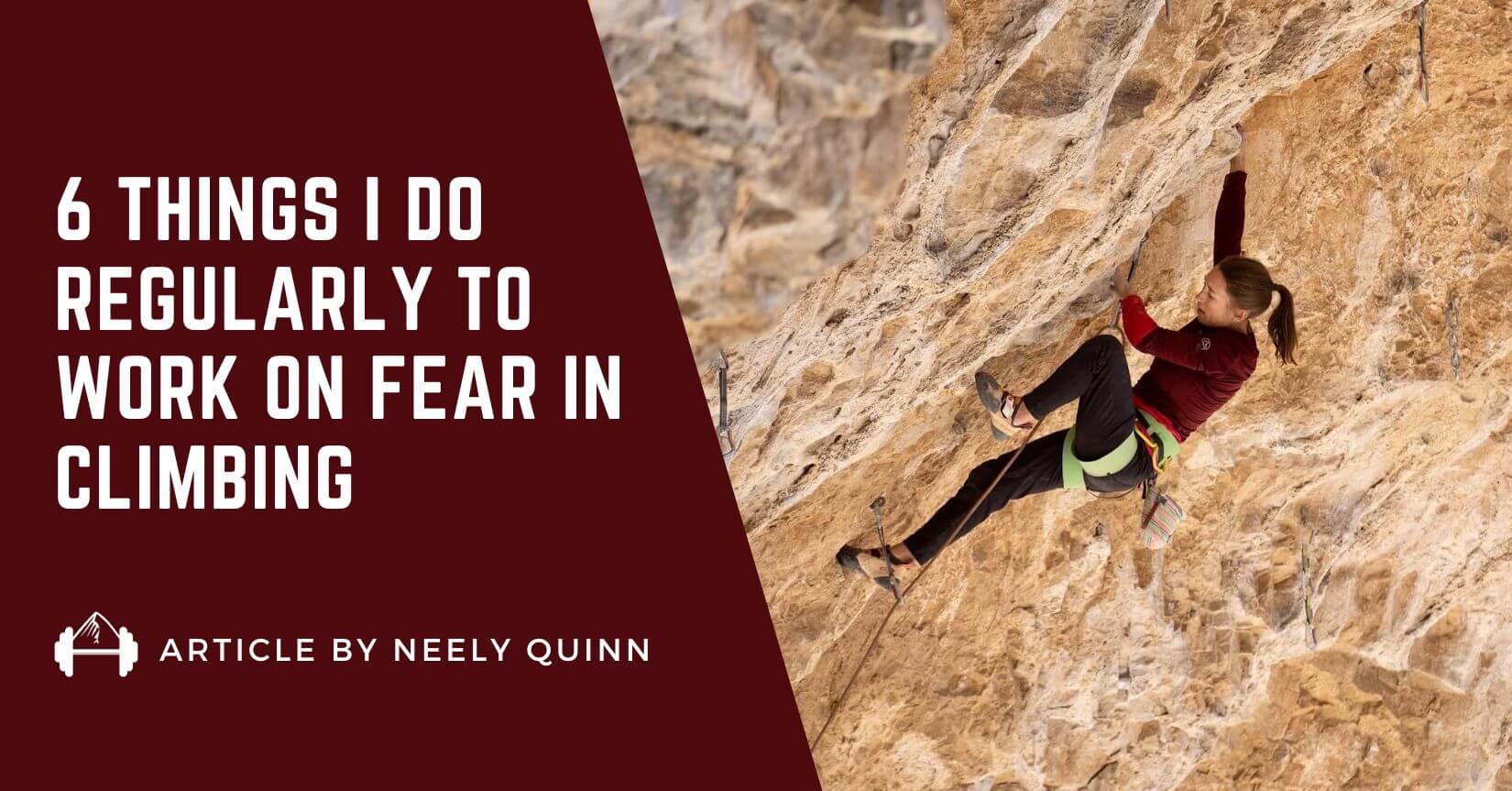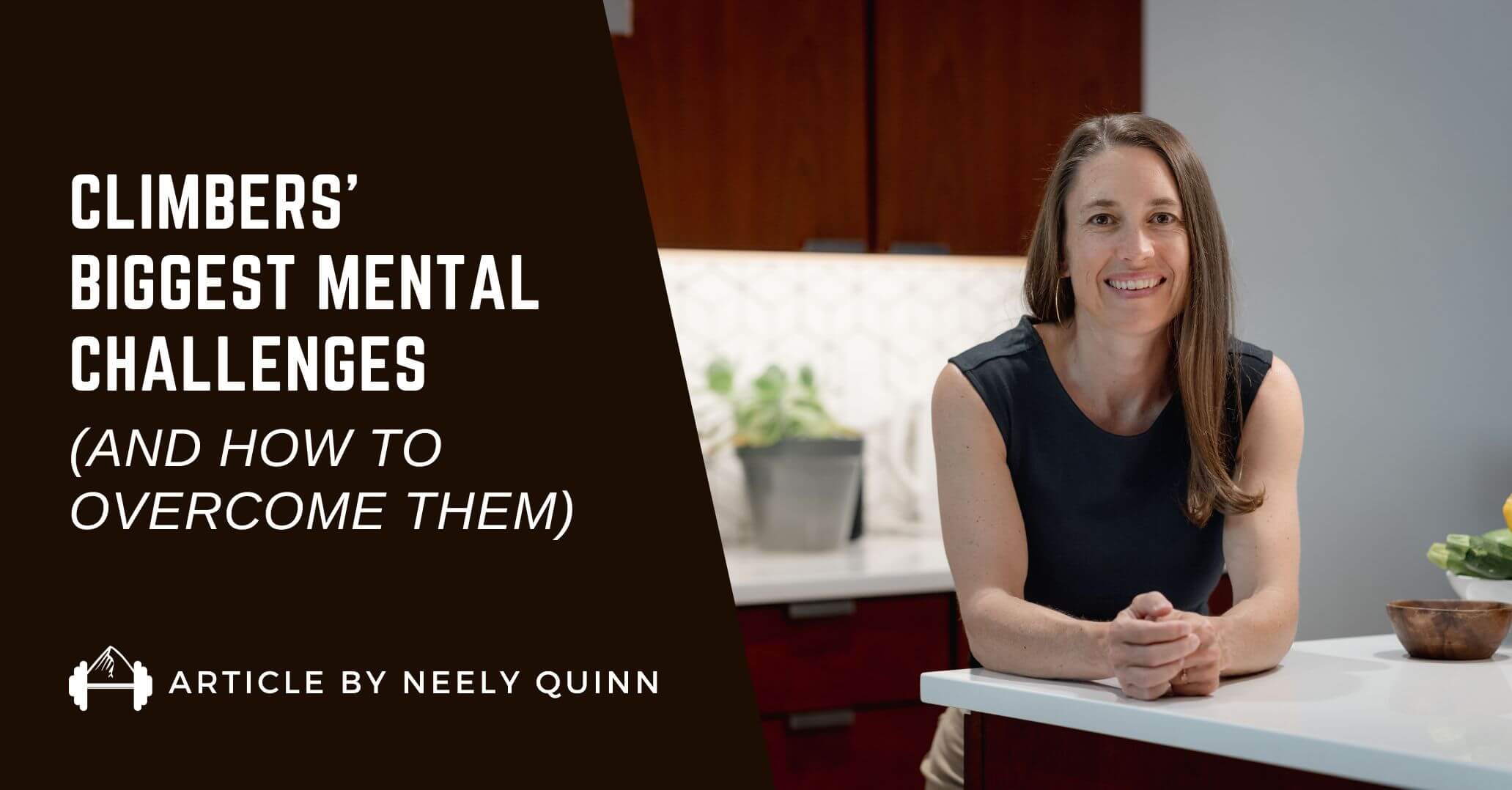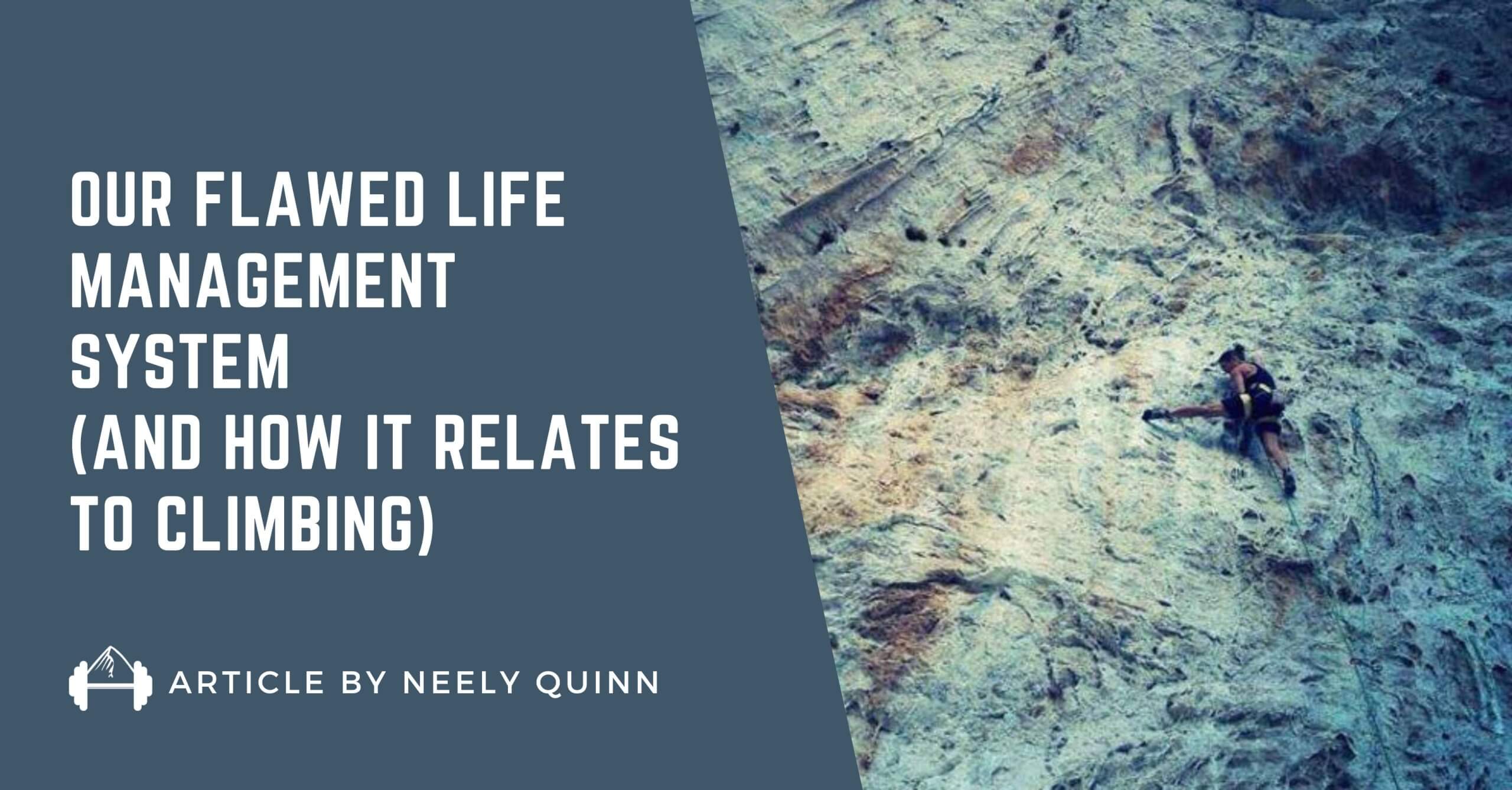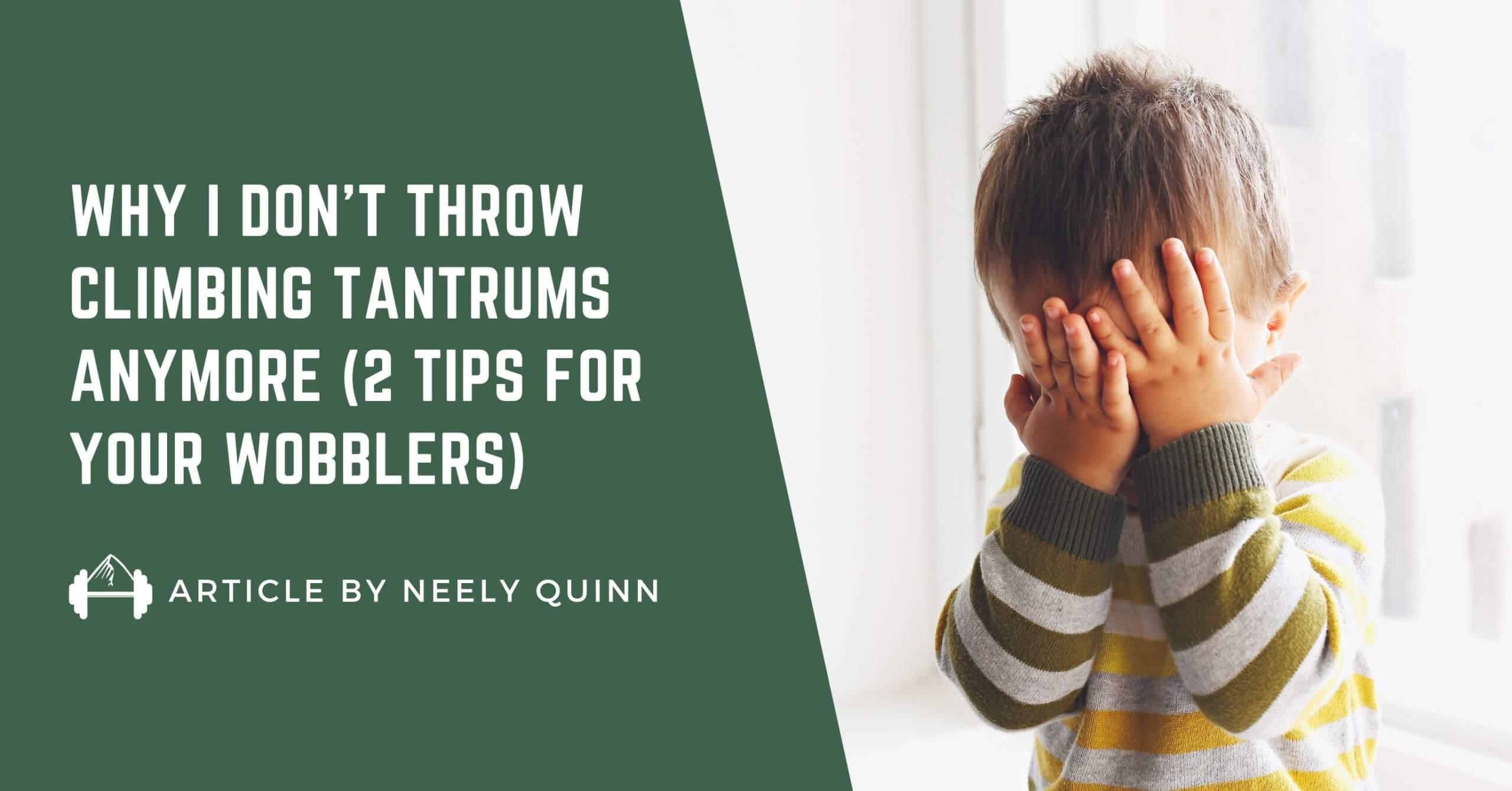I’ve talked a lot over the years about my fear in climbing and how I have, well, a lot of it. Compared to some people, that is. I know there are plenty of people who will not lead climb or take falls or do some of the things that I do, so I’m not saying I’m the most scared climber out there. I just have fear more than some of my climbing partners do, and I’ve done a lot of work on it over the years, and in this article I’m going to share 6 of the things I do to overcome fear in climbing.
I just got an email from someone about all of this and I started to reply back to her with a LOT of thoughts, so I figured I’d just make it into a post here for everyone to see instead.
Here’s the email I just got, and I’ll keep it anonymous:
i recently listened to this relatively older episode (tbp 125 with JStar where he talks about Spain and his Planta de Shiva process) and wanted to let you know that what impacted me most was your contribution to this episode. while listening to his process and his experience was also great, i really appreciated your honesty and insight about how you climb with fear almost all of the time. i think this can be hard to talk about/admit for many, and it was validating and empowering for me to hear you talk about it openly. im sure you know this, but if you dont– you are not alone. i think for a long time i thought i “wasn’t a real rock climber” or “didn’t belong” because i climb with fear. i was and am ashamed of this.
i recently moved from a place where i could climb every weekend, and sometimes after work on weekdays, with a crew of try hard local crushers. i was sometimes ashamed to climb with them due to underperformance and fear i could not fully understand. i have worked with my therapist on where it might come from, what the irrational thoughts are rooted in, and how to navigate these fears, and honestly, i kinda came up empty. i’m letting go of where it comes from/getting to the root of it now, and just trying to get more exposure on real rock, because in general, the fears are not that rational. this is especially hard because im also a grad student, living in a place without great access to outdoor climbing. but i’ll take what i can get, and try my best to be grateful for it.
all that to say, you’re an inspiration to me, and i wanted to let you know that your honesty and vulnerability impacted me positively. thanks for all you do with trainingbeta/the podcast. its a great show! AND thanks for telling me to eat breakfast a couple years ago when i reached out about nutrition stuff– turns out that when you eat three meals a day and include carbs, you can generally sleep and perform much better. who knew?! hope you’re doing fantastic.
many thanks
Here’s my response to this amazing person 🙂
Thank you so, so much for reaching out to say that to me! I really can’t describe what it means to me to get feedback like this about the podcast and my vulnerability on it. It’s hard to know how it sits with people, so I’m glad that it resonated with you and helped to validate you. It’s really hard feeling like you’re the only one who experiences this, especially when you’re constantly climbing with braver, stronger people than you.
Over the years even since that episode I’ve done a lot of work on my fear, and it’s improved quite a bit. I’m still scared – don’t get me wrong – but I find myself being way braver climbing inside and outside and sometimes surprising myself because of it. If you don’t mind me sharing, here are some of the most important things I’ve done to help myself have a lot more fun while climbing.
How I Manage and Overcome My Fears in Climbing
If these things haven’t directly decreased my fear, they’ve at least directly decreased my shame around the fear. Here goes…
1. Take a lot of practice falls in the gym and outside when possible.
When I started doing this last year it kind of changed my life! I play this game with one of my friends where we belay each other and the belayer gets to say “fall” whenever we want the climber to fall and the climber then has to let go. It’s helped both of us SO MUCH. We had to work up to this, though. At first we started by falling on toprope, then just above our bolt, all while pausing and looking down and asking if our belayer was ready for us to fall.
We graduated to taking unannounced falls wherever we wanted to, and THEN the fall game started happening. It’s really, really helpful and has increased both of our confidence levels and our trust in each other.
2. Learn the physics of falling.
When you take all these practice falls, you start to really understand what will happen when you do fall. I’d imagine the absolute worst happening at every bolt before, but now with all of my practice falls inside and outside with all different partners, I’m learning more about the reality of physics and I’m freaked out a lot less. Usually my mental calculations were way off before.
Now I feel more capable of seeing things clearly, like my husband has always been able to do (he’s one of those stronger, braver climbers I’m always climbing with and comparing myself to.)
3. Acknowledge that the fear is sometimes 100% rational and valid.
It is NOT irrational at all to be afraid of putting your life literally in someone else’s hands and trusting someone else’s bolting and someone else’s rope manufacturing, etc. It’s especially scary if you don’t fully trust the person’s ability to catch you properly.
Just being able to say to myself, “Of course, I’m scared. I think she’s actually going to drop me to the ground if I fall because she’s not experienced enough to know better.” Or “I’m not so sure about this fall, which is understandable because there’s a ledge down there and it’s possible I could hit it.” It’s just about what you do then. Maybe you stop, collect yourself, acknowledge your fear, validate it in the way I just did above, and then take practice falls that are bigger and bigger to see exactly what happens when you do fall.
We are doing an extreme sport and anyone who tells us anything different is delusional. It is scary and sometimes I think people who take big risks are being more delusional than I am when I’m scared.
Again, it IS scary, and it’s ok to be scared. It’s also ok to opt out of this sport or just toprope if that makes you have more fun and enjoy it more. My mother-in-law only topropes and she climbs 5.12, and she’s 100% ok with that. But mostly, just acknowledging it and validating it to YOURSELF and for yourself, even out loud in a whisper when you’re up there, can be really freeing.
4. Acknowledge and accept that we all come to the cliff with different anxiety levels.
I also have come to realize and accept that we’re all very different in the amount and kind of anxiety we bring to the table and how it shows up when we’re climbing. For instance, I’m prone to anxiety and fear, no matter how much therapy I do or how many years I’ve been on medication. It’s how I’m built and this is due to my genes, my environment, and my experiences. I don’t have control over that. Other people are NOT as prone to fear and anxiety – they’re just not built that way.
I had a bit of a complicated family life growing up that left some scars on my mental health. I have body shame because I’m a woman who doesn’t look like a super model. I have fear walking around in public because I’m a small, rather defenseless woman. I have health issues that I’m constantly dealing with. I’ve had 5 orthopedic surgeries that I’ve had to recover from. I am a woman who has a natural hormonal cycle that affects my fear and anxiety levels. I am short and therefore I have to watch my feet go farther above my last bolt than a tall person. And because I’m short, I have to do more dynamic movements than a tall person, which is really insecure and scary. And on and on. All of this together fills up a fear and anxiety bucket that I carry around with me all day every day.
That means when I tie in to climb, my natural confidence levels are sort of muddled and canceled out by all of this other gunk I’m carrying around, if that makes sense.
When you compare that with a person whose natural state is calm and balanced, who did not have much trauma as a child, who’s never had body shame, who is average height or above, who doesn’t have cyclical hormonal shifts in their fear levels, who has only ever had financial security, who doesn’t have constant fear walking around in public because they are a man and/or have never been sexually harassed, who’s never really been injured, and on and on… You can imagine that that person’s confidence bucket is going to be a little bit fuller than mine, per se.
When I realized this was a thing and that there are only so many things I can control in my life, I just kind of threw my hands up in the air and was like, “Some days are better than others and I can only control so much. I have fear and I’ll do things to work around it AND I’ll do things to address it.”
5. Use tools and systems to mitigate fear at the cliff, in the gym, and off the wall.
There are a lot of little things I do on routes that some people just don’t need to do because they have less fear than me, and that’s ok. Here are some of the things I do to mitigate my fear on the wall that keep me motivated to continue with this sport that I love.
- I use stick clips often at cliffs and sometimes at the gym. I’ve become pretty good at stick clipping, which is handy because stick clipping can be extremely frustrating, especially up on a route.
- I have a long stiffy draw that I carry with me on new hard routes just in case I need to cheat my way through a section.
- If I feel unsafe in the gym (this just happened yesterday on a longer runout at bolt 3), I am not ashamed of grabbing jugs next to me, making the clip, and continuing on with the route.
- I will sometimes toprope intimidating routes on my first or second try just to take away as many unknowns as possible.
- I will elongate draws outside to make clips easier and less scary.
- If I know I’m about to get my period (that’s when I’m the most hormonally scared), I’ll take it easy on myself and toprope more or just work certain sections of routes instead of going all out.
I have taken a lot longer to send some routes than I would have if I hadn’t been so scared on the first few trips up the route, but I’ve accepted this as part of my process. I still get to climb, be outside, experience the learning and growing that comes from all of it, and send sometimes! So it’s all worth it.
As far as things I do off the wall to mitigate fear on the wall, I have designed my life to be as low stress as possible while also being fulfilling.
I don’t work more than my nervous system wants me to, I don’t exercise too much, I eat really well, drink plenty of water, I don’t drink alcohol almost ever, and I sleep a lot. I have a gratitude practice after climbing days to keep me focused on the positives instead of the negatives. I see a therapist regularly to help me process stressful things in my life. I’ve eliminated toxic relationships from my life.
I don’t read too much news and I’ve curated my Instagram feed to be pretty much exclusively cute foxes, Australian cattle dogs, and dad jokes. My marriage is peaceful, we don’t live beyond our means, we live in places we love, and I do work that I love doing. And most of all, I don’t have kids. This is all by design so that I can have a clear head most of the time, despite the baggage I carry around with me.
6. Talk to your belayer and teach them what you want.
This one is probably the hardest, and I’ve had to have a lot of uncomfortable chats with people I love and people I don’t know very well. I’m ok with that, and you should be too because it’s your life you’re talking about. When I watch people belay, I watch how much slack they’re leaving out, how far away from the wall they are when they belay, if they’re paying attention or chatting with people, if they’re holding the grigri break down all the time, if they jump when their climber falls or pull in slack (depending on the situation), and how attentive they are to their climber in general.
I will not climb with people who aren’t doing all of those things right. It’s not worth it to me to risk injury or death just to avoid hurting people’s feelings when I tell them I don’t want them to belay me. That means I’m picky about who I invite to climb with me, and if I’m in a threesome, I’m vocal about the belay order so that I’m belayed by someone I trust. Ok, so now that that controlling part of me is on display for the public, let’s talk about conversations.
I went climbing with a close friend in the gym last year (we’d never climbed in the gym together before that). I was up on a warmup at the third bolt and looked down and noticed she had so much slack out that if I were to fall, I’d definitely hit the ground. I didn’t want to offend her, but I also wanted to have a good session and be able to comfortably climb with her again in the future, so I made it into a learning experience for both of us. I told her about my concerns in a neutral way and asked her if she’d be willing to hear out some requests and then catch me on some practice falls.
She was totally willing to hear me out and make it into a learning session. She said she’d been taught that when a climber is lighter than her, which was the case with us, that you just feed out a lot of slack and that should make for a soft catch. It came as a surprise to her that she could have injured me by leaving out that much slack in the first couple bolts, so that was lesson 1. Then I taught her how to stay close to the wall, not leave out much slack, and jump when I fell. It took a couple practice falls, but she definitely got it, and I felt WAY safer afterward and so did she. All the falls I took were soft, short, and safe. It ended up being really fun.
I’ve had to do this numerous times with people. It’s ironic because small people are always afraid of being slammed into the wall because we’ve all had it happen, so it makes falling that much scarier for us. But then people are taught that they should just give small people a ton of slack, which is even scarier. So we have to educate people about what we want. No matter what size you are, we all need to educate people about how we want to be belayed, make requests, call out things that aren’t right, and make it safe.
Honestly, I could go on about all of this forever. Climbing is such a huge part of my life and I spend so much time doing it and thinking about it… I’ve had coaching and therapy about all of this, and I work on it constantly. I’ve really made huge strides in my confidence and willingness to take falls and climb into unknown territory. But I’ve been climbing for 25 years and it’s taken a LOT of time and effort!
My main advice is to just be kind to yourself and climb with people who are kind to you and who don’t put pressure on you to do things you don’t want to do. Your fear is valid to a point. It’s an inherently scary sport – that’s part of the fun of it. But when we come to the table with a lot of fear already built into us, it’s going to feel that much scarier, no matter how much we love the sport. So be gracious, validate your feelings, and move on or come down and try again later.
I hope this is helpful! I’d love to hear in the comments how YOU deal with fear and what you think about what I’ve written!
Work with Me on Your Own Fears in Climbing
If you want help with your fears in climbing, your mindset overall, or anything else in your life, I’m a Certified Professional Coach, aka a mindset coach, and I’d love to work with you. We can talk through the origins of your fears, what is actually going on underneath them, and what you can do that is specific to YOU to start to work with them and overcome them. Whether it’s fear of failure, fear of success, fear of being in the spotlight, or fear of experiencing discomfort due to trying hard (or anything else), we can work through it.
About the Author, Neely Quinn

Neely Quinn is the founder of TrainingBeta.com, the host of the TrainingBeta Podcast, a Certified Integrated Clinical Nutrition Therapist specializing in rock climbers, and a Certified Professional Coach who helps climbers with their mindset. She has been climbing since 1997 and is continuously striving to become a more masterful climber using training, nutrition, and mindset. She lives in Longmont, Colorado and Las Vegas, Nevada with her husband and co-founder of TrainingBeta, Seth Lytton, and their heeler mix, Willa.
You can find her nutrition services here and her coaching services here.








Leave A Comment